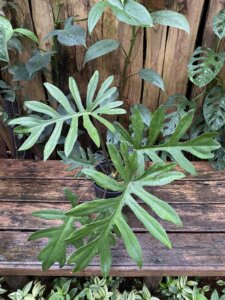Basic Information
Tropical philodendrons are popular houseplants due to their easy-care nature. Philodendron Mayoi, a rare species, is in high demand. It has large, palm-like leaves with a red tinge on its stalks and veins. As it grows, its glossy green lobes deepen and widen. Philodendron Mayoi can grow over 6 feet tall and is perfect as a dramatic floor specimen.



Light
The Philodendron Mayoi flourishes in bright, indirect sunlight, making it an ideal plant for spaces near large windows. However, care should be taken to avoid prolonged direct sunlight exposure, as it can cause leaf scorching. Interestingly, this resilient plant can tolerate a few hours of direct sun (about 2-3 hours) daily. The Mayoi can survive in low-light conditions, but its growth may become stunted and leggy. The optimal setup would be a location where the plant receives ample indirect light for most of the day, ensuring its leaves develop healthily and maintain their vibrant appearance.
Water
To keep your Philodendron Mayoi healthy, it’s important to find a balance when watering it. The soil should be consistently moist but not too wet, as too much water can cause root rot, and too little water can result in brown leaves. To check if the soil is dry enough to water, insert a finger 2-3 inches deep into the soil; if it feels dry, it’s time to water the plant. Generally, the plant needs to be watered every 7-10 days, but this may vary with seasonal changes. Using rainwater or dechlorinated tap water is recommended as it mimics the plant’s natural environment and can be beneficial.
Soil
When it comes to taking care of a Philodendron Mayoi, it is essential to use a soil mix that drains well. To achieve this, a combination of potting soil, peat, bark, and perlite is recommended. Perlite helps to aerate the soil and regulate moisture, which is crucial for this tropical plant. The soil should be able to support root health by preventing waterlogging while providing the necessary nutrients for growth.
Temperature
Philodendron Mayoi is a tropical plant that thrives in warm temperatures ranging from 16°C to 28°C (60°F to 82°F). It is important to maintain a consistent warm temperature, even at night, preferably around 16°C (60°F). To avoid foliage damage and hindered growth, it’s crucial to protect the plant from temperatures below 13°C (55°F) and cold drafts.
Humidity
The Philodendron Mayoi is a tropical plant that prefers a medium to high humidity environment. However, it is adaptable and can tolerate lower humidity levels commonly found in most homes. This makes it a great choice for indoor settings that do not have specialized humidity control..
Fertilizer
When fertilizing your Philodendron Mayoi, it’s best to use a liquid fertilizer that has been diluted. Apply this fertilizer once a month during the growing seasons which are spring and summer. While the plant can survive without regular fertilization, providing it with nutrients during its active growth periods can improve its overall health. Natural fertilizers such as coffee grounds or green tea leaves can also be helpful, particularly in promoting growth during slower periods.
Growth Rate
The Philodendron Mayoi is a type of plant that is renowned for its speedy growth. It can easily adapt to indoor conditions and will display new growth every couple of weeks provided that it is being cared for properly. However, given its rapid growth, it requires ample space, especially for its climbing and trailing tendencies. To ensure that it grows healthily without becoming overcrowded, regular observation and adjustments in its placement are necessary.
Pet Safety
Philodendron Mayoi is poisonous to pets and humans due to calcium oxalate crystals. Keep it out of reach to ensure safety.
Grow in Semi-Hydro
- Philodendrons, celebrated for their lush foliage and adaptability, thrive in semi-hydroponic systems such as LECA/Pon, thanks to their resilient root systems and preference for consistent moisture.
- Shifting a Philodendron to a semi-hydroponic setting works well using a Nutrient Stagnant Wicking (NSW) method, providing a stable and effective environment for growth.
- Within the LECA/Pon environment, Philodendron roots adapt swiftly, effectively managing any early challenges in adapting to the NSW system.
- For nourishing Philodendrons in semi-hydro systems, a nutrient solution with a concentration around 800-1000ppm is optimal.
- Philodendrons are versatile in adapting to a range of temperature and humidity levels, making them ideal for various indoor settings.
- Regular care involves keeping an eye on the water level in the reservoir and periodically flushing the system to ensure the Philodendron’s healthy and consistent growth.
- If your Philodendron is a climber, it’s a must to look at our Moss Pole guide to have a proper set-up.
Tips
- Rotate the plant regularly for even growth.
- Trim any yellowing or damaged leaves to promote healthier growth.
- If using tap water for watering, let it sit for a day to evaporate chlorine, which can be harmful.
- Clean leaves with a damp cloth to remove dust and aid photosynthesis.
- Repotting every 1-2 years in a slightly larger pot can encourage growth and prevent root bounding.
Ensuring the Philodendron Mayoi thrives in an indoor environment, bringing tropical greenery to your space, requires attention to several key aspects.
Happy planting! 🌱


